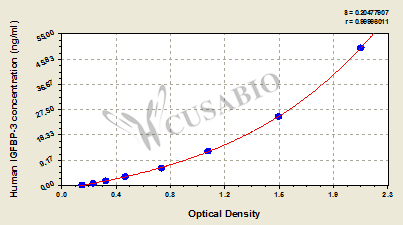The product CSB-E04590h is a sandwich ELISA kit developed to measure concentrations of human IGFBP3 in serum, plasma, or tissue homogenates. This assay uses the sandwich enzyme immunoassay technique in combination with the enzyme-substrate chromogenic reaction to quantify the analyte in the sample. The color develops positively to the amount of IGFBP3 in samples. The color intensity is measured at 450 nm via a microplate reader.
IGFBP3 can regulate the mitogenic activity of insulin-like growth factor 1 receptor (IGF1R). IGF-independent roles of IGFBP3 include its interactions with the extracellular, membrane, and intracellular proteins and translocation into the cytoplasm and into the nucleus. Aberrant expression or malfunction of IGFBP3 is related to cancer development and progression. IGFBP3 functions as either an oncogene or tumor suppressor depending on the cellular context and tumor type. A series of studies have shown that IGFBP3 inhibits cell adhesion, invasiveness of endometrial cancer, metastasis in prostate cancer, and angiogenesis in head and neck squamous cell carcinoma. On the contrary, IGFBP3 has antioxidative activity, inhibiting ROS, and enhancing epithelial-to-mesenchymal transition and motility, which is required for tumor progression.






